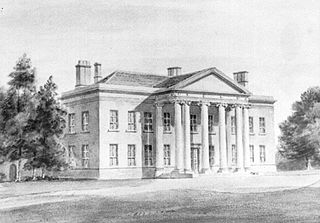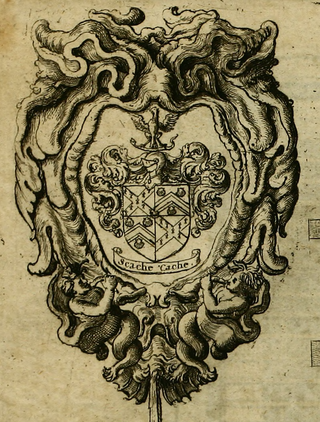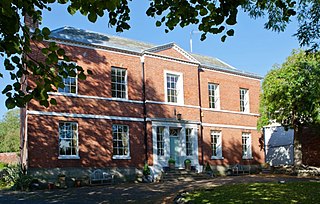Related Research Articles

Thomas Pitt of Blandford St Mary in Dorset, later of Stratford in Wiltshire and of Boconnoc in Cornwall, known during life commonly as Governor Pitt, as Captain Pitt, or posthumously, as "Diamond" Pitt was an English merchant involved in trade with India who served as President of Madras and six times as a Member of Parliament. He was the grandfather of William Pitt, 1st Earl of Chatham and was great-grandfather of Pitt the Younger, both prime ministers of Great Britain.

Caldicot Castle is an extensive stone medieval castle in the town of Caldicot, Monmouthshire, in southeast Wales, built near the site of Harold Godwinson's former Saxon castle by the Norman earls of Hereford from about 1100. The castle became a Grade I listed building on 10 June 1953.

The Longfellow House–Washington's Headquarters National Historic Site is a historic site located at 105 Brattle Street in Cambridge, Massachusetts. It was the home of noted American poet Henry Wadsworth Longfellow for almost 50 years, and it had previously served as the headquarters of General George Washington (1775–76).
The High Sheriff of Berkshire, in common with other counties, was originally the King's representative on taxation upholding the law in Saxon times. The word Sheriff evolved from 'shire-reeve'.

Spye Park is a former country estate in Bromham parish in Wiltshire, England. It lies north of Chittoe, about 1.5 miles (2.4 km) north-west of Bromham village and 2.5 miles (4 km) east of Lacock. The historic house which stood there, near the Roman road from London to Bath, had been twice destroyed by fire, most recently in 1974. The new owner, as of 2005, was planning to rebuild a Palladian house.

Oakley Court is a Victorian Gothic country house set in 35 acres (140,000 m2) overlooking the River Thames at Water Oakley in the civil parish of Bray in the English county of Berkshire. It was built in 1859 and is currently a hotel. It is a Grade II* listed building that has been often used as a film location.
Cotheridge Court is a Grade II* listed ancient manor house situated in the south-western part of Cotheridge, in the county of Worcestershire, England, and birthplace of Herbert Bowyer Berkeley. The house bought in 1615 by William Berkeley, eldest son of Rowland Berkeley (1548-1611) of Spetchley, was owned and lived in by the Berkeley family for nearly 350 years, but the manor is over one thousand years old. This family descended from the Berkeleys of Berkeley Castle Gloucestershire, and Eadnoth. Cotheridge Court is now a private residence of sub-divided flats.

Beckett Hall is a country house at Shrivenham in the English county of Oxfordshire. The present house dates from 1831.

Swallowfield Park is a Grade II* listed stately home and estate in the English county of Berkshire. The house is near the village of Swallowfield, some 4 miles south of the town of Reading.
Yattendon Castle was a fortified manor house located in the civil parish of Yattendon, in the hundred of Faircross, in the English county of Berkshire.
Slebech was a community in Pembrokeshire, Wales, which is now part of the combined community of Uzmaston and Boulston and Slebech, a sparsely populated community on the northern shore of the Eastern River Cleddau. The community shares boundaries with the communities of Wiston and Llawhaden and mainly consists of farmland and woodland. Much of the community is within the Pembrokeshire Coast National Park and Picton Castle's stable block loft is an important breeding roost for the rare Greater Horseshoe Bat.

Samuel Backhouse was an English merchant who later became a country gentleman based in the county of Berkshire. He was a member of Parliament (MP) twice early in James I's reign, first for New Windsor in 1604 and then for Aylesbury in 1614.
Sir Standish Hartstonge, 1st Baronet was an English-born lawyer who had a distinguished career as a judge in Ireland, but was twice removed from office. He was also a very substantial landowner in Ireland and England. His last years were marked by bitter family disputes with his eldest grandson, who inherited the baronetcy, but not the family estates, which passed to the judge's youngest surviving son.
Price Hartstonge (1692–1744) was an Anglo-Irish politician who sat in the Irish House of Commons as MP for Charleville from 1727–44.

Duxbury Hall was a 19th-century country house in Duxbury Park estate in Duxbury Woods, Lancashire that has been demolished.

James Pytts was an English landowner and politician who sat in the House of Commons at various times between 1660 and 1686.
Sir John Holcroft of Holcroft Hall, Culcheth, was a soldier, politician, and landowner of the Tudor period. He was returned twice as a member of the English parliament for Lancashire.
William Courtenay, 10th Earl of Devon was a 19th-century British aristocrat and politician, who sat in the Commons before entering the House of Lords after succeeding to the title of Earl of Devon in 1835.

Foliejon Park is a manorial country house in the civil parish of Winkfield in the English county of Berkshire. The building has been listed as Grade II since 7 December 1966 and was the temporary residence of King Haakon VII during the Nazi occupation of Norway.

Breedon Hall, Breedon on the Hill in north-west Leicestershire, is a house of historical significance and is listed on the English Heritage Register. In 1620 it was a small timber-framed cottage. Soon after it was bought by the Curzon family and was successively enlarged until 1777 when it was given a new Georgian front. It was the ancestral home of the Curzons for over three centuries and then bought by the Shields family. Today it is owned by the Meynell family and provides bed-and-breakfast accommodation.
References
- ↑ Historic England. "Farley Castle (1319147)". National Heritage List for England . Retrieved 10 December 2013.
- ↑ Mitchell-Hedges, F.A., Danger My Ally, Elek Books, London, 1954.